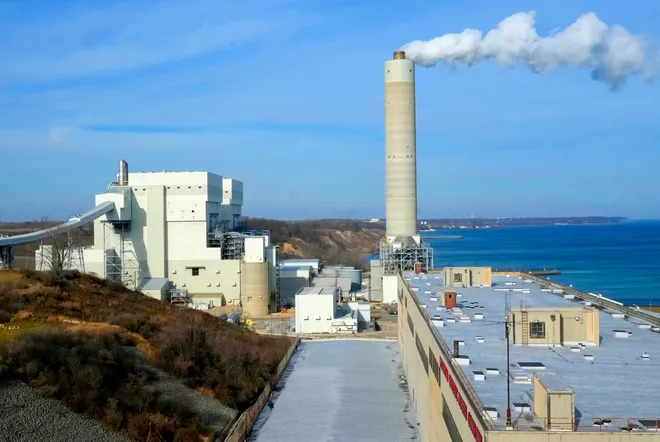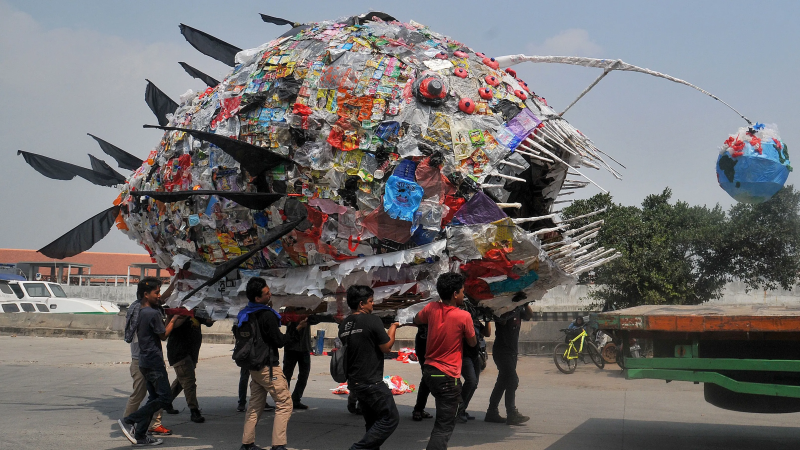Long-term coal power plants must control 90% of their carbon pollution, new EPA rules say
The Environmental Protection Agency released long-awaited, updated power plant standards Thursday, aiming to further reduce air pollution that makes people sick and the greenhouse gases emissions warming the planet.
Federal officials said Wednesday the rules will deliver on the Biden Administration's commitment to provide health protections for communities, including those confronted with decades of environmental injustices.
"Since the start of this administration President Biden has made it clear that we are committed to the integrated priorities of ensuring US energy security, protecting people from pollution and fighting the climate crisis," said EPA Administrator Michael Regan.
The four new rules will do just that by reducing pollution from fossil fuel-fired power plants, protecting communities from pollution and improving public health, Regan said, all while "supporting the long-term reliable supply of the electricity needed to power America forward."
The Department of Energy also announced a new rule designed to make the permitting process for building energy transmission infrastructure "more efficient and effective," said Energy Secretary Jennifer Granholm.
Together, the rules are expected to spur up to $370 billion in climate and public health net benefits over the next two decades, while providing a more predictable regulatory outlook for power companies, the officials said. The EPA said it doesn't expect any negative impacts to electricity generation or grid reliability.

What are the new power plant rules?
The EPA said the four new rules do the following things:
- Require all coal-fired power plants that plan to run in the long-term, and all new natural gas-fired plants, to control 90% of their carbon pollution.
- Strengthen and update mercury and toxic air standards for coal-fired power plants, tighten the emissions standard for toxic metals by 67%, and reduce emissions of mercury and other contaminants that are important for children and others who regularly consume fish with high levels of pollutants from power plants.
- Reduce pollutants discharged through wastewater from coal-fired power plants by more than 660 million pounds per year by setting wastewater discharge standards.
- Require the safe management of coal ash placed in areas previously unregulated at the federal level, including at previously used disposal sites.
Earth Day 2024Experts are spreading optimism – not doom. Here's why.
What's the impact of the new rules?
They are "a big deal," Ben Jealous, executive director of the Sierra Club, told USA TODAY on Wednesday. "They're saying power companies are going to have to do a much better job of being a better neighbor."
The nation has made major improvements at improving air quality and reducing emissions in recent decades by shutting down 382 coal-fired power plants, Jealous said. The newer standards are expected to move those efforts even farther forward.
"Bad actor power plant operators will now have to think twice about continuing to operate their dirty polluting power plants," Jealous said. He added the rules also "will accelerate our movement to transition the country towards renewables."
"The bottom line is this will add up to fewer kids having asthma attacks and fewer adults having heart attacks," he said. "Millions of people will have cleaner air and cleaner water."
Despite the previous gains, the State of the Air report released by the American Lung Association this week said 131.2 million people across the nation still live in places with "failing grades" for unhealthy levels of ozone and particle pollution.
What are the health benefits of the new rules?
The administration projects the following outcomes for the year 2035:
- Up to 1,200 avoided premature deaths
- 870 avoided hospital and emergency room visits
- 1,900 avoided cases of asthma onset
- 360,000 avoided cases of asthma symptoms
- 48,000 avoided school absence days
- 57,000 lost workdays
USA TODAY Investigation:Across America, clean energy plants are being banned faster than they're being built
Questions raised about the rule
Congressman Andrew Garbarino, R-New York, sent a letter to Regan this week questioning the EPA's authority to regulate power plant emissions.
He cited a 2022 decision by the Supreme Court, which ruled against the agency in a case about its efforts to do so. That decision is "a red light flashing at EPA," Garbarino wrote, because it stated new standards should be determined by legislation rather than agency rule.
His letter also chides the agency for relying on "antiquated, inefficient command-and-control regulatory mechanisms."
However, the League of Conservation Voters said the EPA is following the guidelines established by the Court's decision, and stated Congress has reinforced its intent for the EPA to regulate power plants by amending the Clean Air Act through the Inflation Reduction Act.
What's the biggest source of greenhouse gas emissions in the U.S.?
About 30% of carbon dioxide emissions come from the electricity sector, according to the EPA's website. The largest share – 35% – come from the transportation sector, which generates about 24% of total greenhouse gas emissions in the nation. The EPA reports that burning coal produces more carbon dioxide than natural gas or oil.

Moving along efforts for energy transmission and 'clean' vehicles
The new electrical transmission line rule sets a binding two-year timeline for federal agencies to issue authorizations and permits, cutting in half the average time a developer spends to acquire permits, Granholm said. The rule also require the developers of transmission lines to develop public participation plans when they apply for permits, she said.
The EPA on Wednesday announced the launch of a nearly $1 billion grant program, funded through the Inflation Reduction Act, to replace heavy-duty vehicles with zero-emission vehicles. The program will support projects bringing electric school buses, garbage trucks and delivery vans to neighborhoods across America, said John Podesta, a senior advisor to Biden on international climate policy.
“These announcements are a huge step toward electrifying trucks and buses across the country, especially in communities disproportionately impacted by toxic tailpipe pollution, said Darien Davis, the government affairs advocate for climate and clean energy for the League of Conservation Voters.
Estefany Carrasco-González, senior director of the Chispa League of Conservation, said the funding and tax credits for clean vehicles mean " there’s never been a better time to replace aging diesel buses with a clean ride for kids."
Dinah Voyles Pulver covers climate and the environment for USA TODAY. Reach her at dpulver@gannett.com or @dinahvp.
Disclaimer: The copyright of this article belongs to the original author. Reposting this article is solely for the purpose of information dissemination and does not constitute any investment advice. If there is any infringement, please contact us immediately. We will make corrections or deletions as necessary. Thank you.






